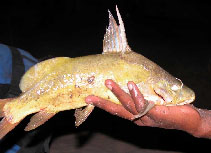| Family: |
Mochokidae (Squeakers or upside-down catfishes), subfamily: Mochokinae |
| Max. size: |
37 cm SL (male/unsexed); max.weight: 500.0 g; max. reported age: 12 years |
| Environment: |
benthopelagic; freshwater; pH range: 6 - 8; dH range: 30, potamodromous |
| Distribution: |
Africa: found practically in all basins of West Africa, except for the coastal basins of Guinea, Sierra Leone and Liberia (Ref. 57223), but including Senegal, Gambia, Volta, Niger and Chad basins (Ref. 3202), and Cross River in Nigeria (Ref. 81251). Also Nile basin downstream of Murchison Falls, including Lake Albert (Ref. 28714, 78218); Lake Turkana (Ref. 52331, 78218); and Ethiopian lakes Abaya and Chew Bahir [= Stephanie] (Ref. 78218). Also reported from Uebi Guiba (Uebi Shebeli) (Ref. 3202). Reports from Athi and Tana rivers are misidentifications probably refering to Synodontis zanzibaricus (Ref. 52331). |
| Diagnosis: |
Dorsal spines (total): 1; Dorsal soft rays (total): 6-7; Anal spines: -0. Diagnosis: gill slits not extending ventrally beyond pectoral-fin insertions (Ref. 28714, 57223). Body long, its depth 20-29% of SL (Ref. 28714). Post-orbital length at least 60% of snout length (Ref. 57223, 81251). Eye contained 1.75-2.25 times in interorbital width (Ref. 4903). Maxillary barbels longer than head (Ref. 57223, 81251) but not reaching to pelvic fins (Ref. 57223), unbranched and without tubercles (Ref. 57223, 81251) or distinct basal membrane (Ref. 28714, 57223, 81251). Outer mandibular barbels with few, rather short and simple ramifications (Ref. 57223, 81251). Branches of inner mandibular barbels few, short, simple and tuberculate (Ref. 57223, 81251), at least the anterior ones (Ref. 57223). Mandibular teeth moderately developed (Ref. 57223), movable (Ref. 81251), numbering 24-39 (Ref. 57223, 81251). Entire margin of opercle smooth (Ref. 81251). Dorsal- and pectoral-fin spines straight (Ref. 57223). Pectoral spines strongly serrated with twice the number of serrations along anterior edge than posterior edge (Ref. 81251), denticulations weaker on outer than on inner margin (Ref. 4903, 57223). Dorsal spine prolonged by a short filament (Ref. 81251), smooth anteriorly (Ref. 57223, 81251) except for a few apical denticles (Ref. 57223), and few serrations along posterior edge (Ref. 81251). However, large individuals may also have a weak denticulation on lower half of spine (Ref. 57223). Humeral process pointed and granulose, slightly keeled ventrally (Ref. 57223, 81251), its depth contained 1.8-2 times in its length (Ref. 4903), its posterior tip not or just reaching a point beneath the dorsal fin spine (Ref. 28714). Adipose fin well developed (Ref. 57223, 81251), high, rather close to rayed dorsal fin (Ref. 57223), not rayed (Ref. 28714). Body uniformly coloured or spotted body brownish dorsally, whitish ventrally (juveniles with white markings and black spots); caudal fin without single dark patch at base of each fin lobe (Ref. 81251). Maxillary barbels white or beige; outer margins of caudal-fin lobes more or less dark (Ref. 57223).
Description: snout subconical; lips not developed; pelvic fin reaching to anal fin; caudal fin deeply forked, with upper lobe longer; caudal peduncle longer than deep (0.9 to 1.7)(Ref. 81251).
Coloration: ground colour variable from greenish-yellow to pale brown; ventral areas whitish or light yellow; some individuals have a pattern of very fine specks; fins more or less of the same colour as body; outer margins of caudal-fin lobes black-edged in some individuals; young specimens have a marbled and finely speckled pattern (Ref. 57223, 81251). |
| Biology: |
Maximum TL was recorded at 47.0 cm (Ref. 57223). Omnivore, feeds on insect larvae (Ref. 13868) (especially chironomids, Ref. 28714), nymphs, eggs and detritus (Ref. 13868). Also feeds on molluscs (predominantly, Ref. 4903), fish, bivalves in the Sudd and snails in Gezira irrigation canals (Ref. 28714). Oviparous (Ref. 205). Breeding occurs during the flood season (Ref. 28714). Utilized for human consumption. |
| IUCN Red List Status: |
Least Concern (LC); Date assessed: 02 June 2019 Ref. (130435)
|
| Threat to humans: |
harmless |
Source and more info: www.fishbase.org. For personal, classroom, and other internal use only. Not for publication.

